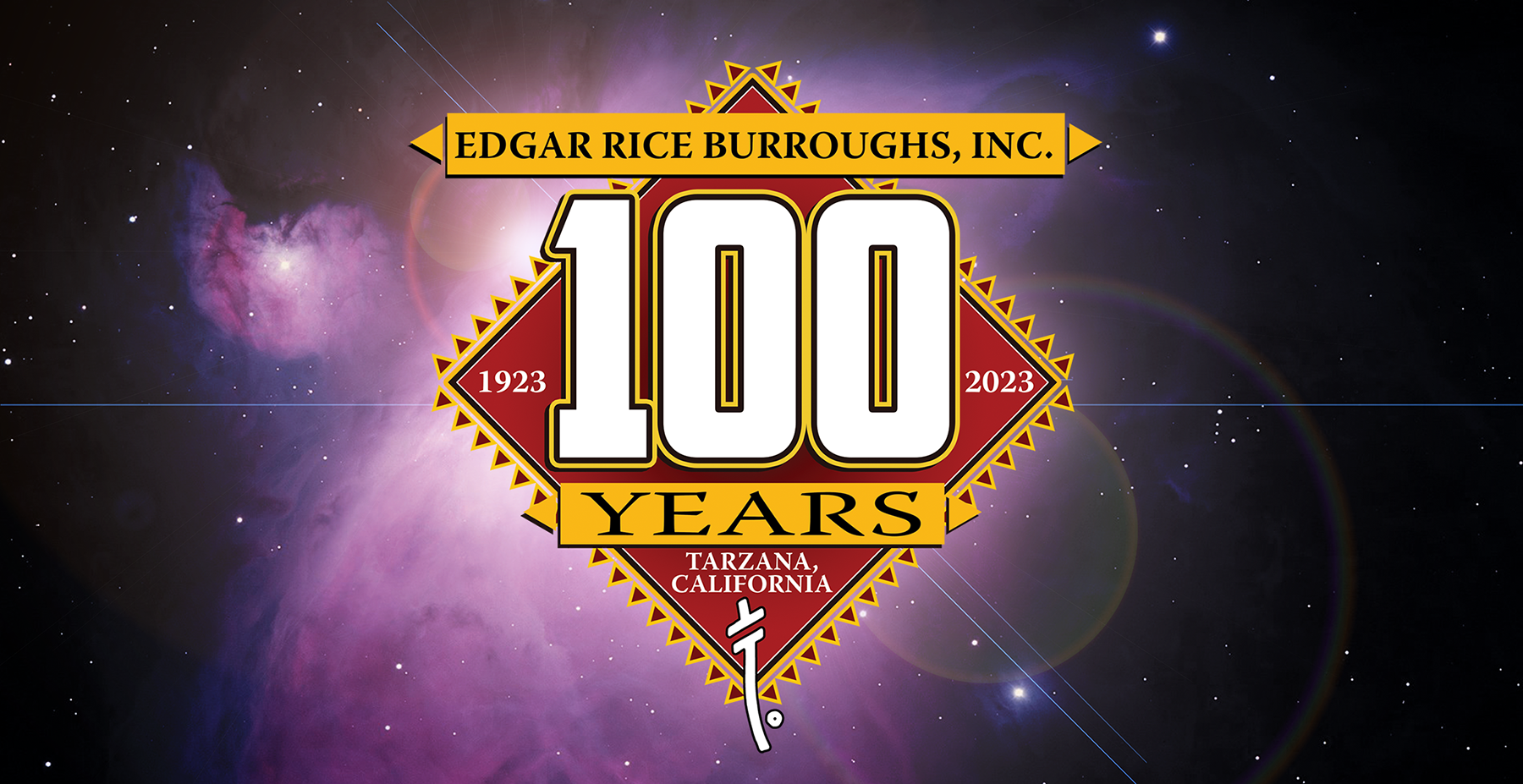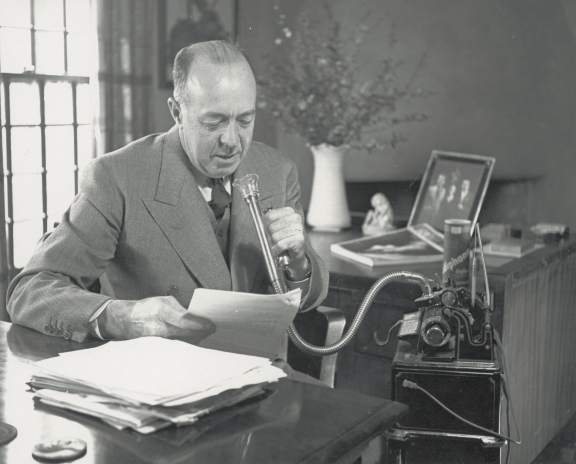100 Years Ago Today
Edgar Rice Burroughs, Inc., Celebrates Its Centennial
On this day one hundred years ago, Edgar Rice Burroughs founded his own company and became the first author to incorporate himself. Today Edgar Rice Burroughs, Inc., is still owned by his heirs; operates out of Tarzana, California, on the property of Mr. Burroughs’ former ranch; and is actively engaged in promoting his legacy and licensing the rights to his works of wonder and imagination.
Edgar Rice Burroughs is the true American success story. From the day he was born, in Chicago, on September 1, 1875, until he submitted one-half a novel to The All-Story Magazine in 1911, he failed in nearly every enterprise he tried. He became a cowboy in Idaho, a U.S. Cavalryman, a shopkeeper, a railroad policeman, a gold miner, and even an “expert accountant,” although he knew nothing of the profession. Throughout this period, he somehow raised money for a number of his own businesses, all of which sank without a trace.
Life was dismal for Burroughs and his wife Emma. He became depressed, his wife discouraged. Perhaps to escape from the grim reality of his own life, or perhaps to amuse Emma, he would often sketch darkly humorous cartoons or write fantastic fairy tales of other worlds.
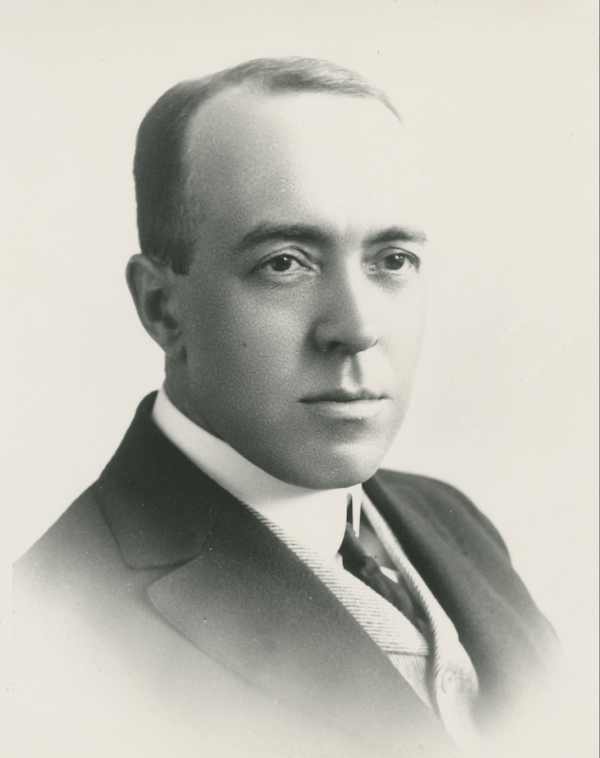 Much later, he was to confirm the fact that he wrote all his stories, particularly those of other worlds, as much for his own enjoyment as for that of his readers: “In all these years, I have not learned one single rule of writing fiction. I still write as I did thirty years ago; stories which I feel would entertain me and give me mental relaxation, knowing there are millions of people just like me who will like the same things I like. Anyway, I have great fun with my imaginings, and I can appreciate—in a small way—the swell time God had in creating the Universe.”
Much later, he was to confirm the fact that he wrote all his stories, particularly those of other worlds, as much for his own enjoyment as for that of his readers: “In all these years, I have not learned one single rule of writing fiction. I still write as I did thirty years ago; stories which I feel would entertain me and give me mental relaxation, knowing there are millions of people just like me who will like the same things I like. Anyway, I have great fun with my imaginings, and I can appreciate—in a small way—the swell time God had in creating the Universe.”
By 1911, Burroughs’ position had become so desperate that not even his cartoons and stories could block out the frustrating fact of his successive failures. He hardly knew where to turn next. Finally, he reached rock bottom. He was thirty-five years old, without a job, without money. There was a wife and two children to support, and a third child was expected soon. He could buy food and coal only by pawning his watch and Emma’s jewelry.
“Then,” he tells us, “somehow I got hold of a few dollars and took an agency for the sale of a lead-pencil sharpener. I would not try to sell the sharpeners myself, but I advertised for agents and sent them out. They did not sell any pencil sharpeners, but in leisure moments, while I was waiting for them to come back to tell me that they had not sold any, I started writing ‘Under the Moons of Mars,’ my first story
“I had no idea how to submit a story or what I could expect in payment. Had I known anything about it at all, I would never have thought of submitting half a novel, but that is what I did. Thomas Newell Metcalf, then editor of The All-Story Magazine, published by The Frank A. Munsey Co., wrote me that he liked the first half of the story and if the second was as good he thought he might use it. Had he not given me this encouragement, I would never have finished the story and my writing career would have been at an end, since I was not writing because of any urge to write nor for any particular love of writing. I was writing because I had a wife and two babies, a combination of which does not work well without money.
“I finished the second half of the story and got $400 for first magazine serial rights. The check was the first big event in my life. No amount of money could possibly give me the thrill that this first $400 check gave me.”
Today, the story is acclaimed by scholars as the turning point of twentieth-century science fiction, and new editions of it continue to be published each year throughout the world.
But Burroughs was still a long way from becoming an established writer. His next literary effort, a historical novel set in the England of the Plantagenet kings, was rejected. He nearly gave up, but his publisher would not hear of it. “Try again,” he urged. “Stick with the ‘damphool’ stuff.”
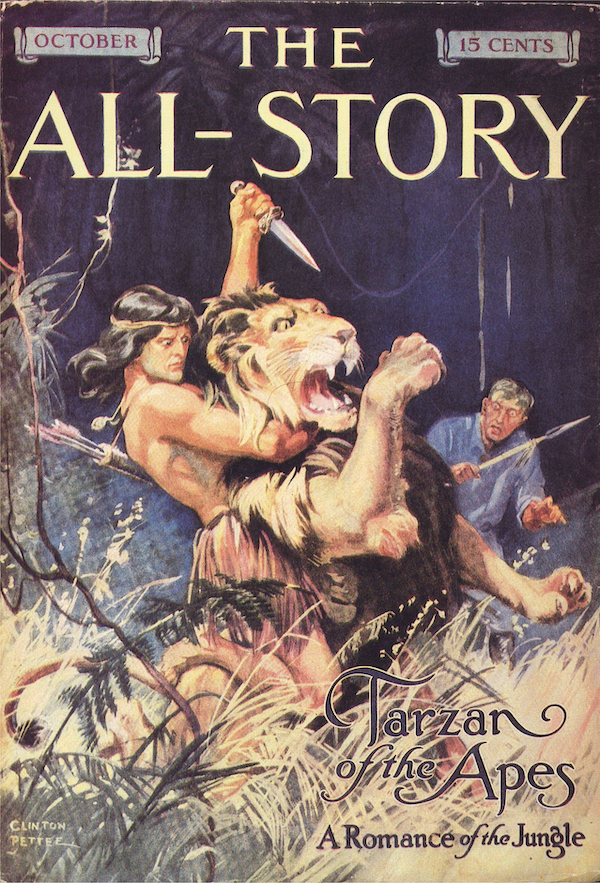 He did, and with his next novel, the future was decided forever. The novel was Tarzan of the Apes. An astonishing success on its appearance in The All-Story magazine in 1912, Tarzan of the Apes brought Edgar Rice Burroughs a mere $700, but after being rejected by practically every major book publisher in the country, it was finally published by A. C. McClurg and Co., and became a 1914 best-seller.
He did, and with his next novel, the future was decided forever. The novel was Tarzan of the Apes. An astonishing success on its appearance in The All-Story magazine in 1912, Tarzan of the Apes brought Edgar Rice Burroughs a mere $700, but after being rejected by practically every major book publisher in the country, it was finally published by A. C. McClurg and Co., and became a 1914 best-seller.
A torrent of novels followed; stories about Mars, Venus, Apaches, Westerns, social commentaries, detective stories, tales of the Moon and of the hollow Earth—and more and more Tarzan books. By the time his pen was stilled, nearly 100 stories bore Edgar Rice Burroughs’ name.
In 1918, Tarzan came to the screen with Tarzan of the Apes, starring Elmo Lincoln, one of the first films in history to gross over one million dollars. Since then, 53 Tarzan films and 250 television episodes have been produced, each a great financial success.
In 1919, with financial security assured, Burroughs moved to California, where he purchased the 550-acre estate of General Harrison Gray Otis, renaming it “Tarzana Ranch.”
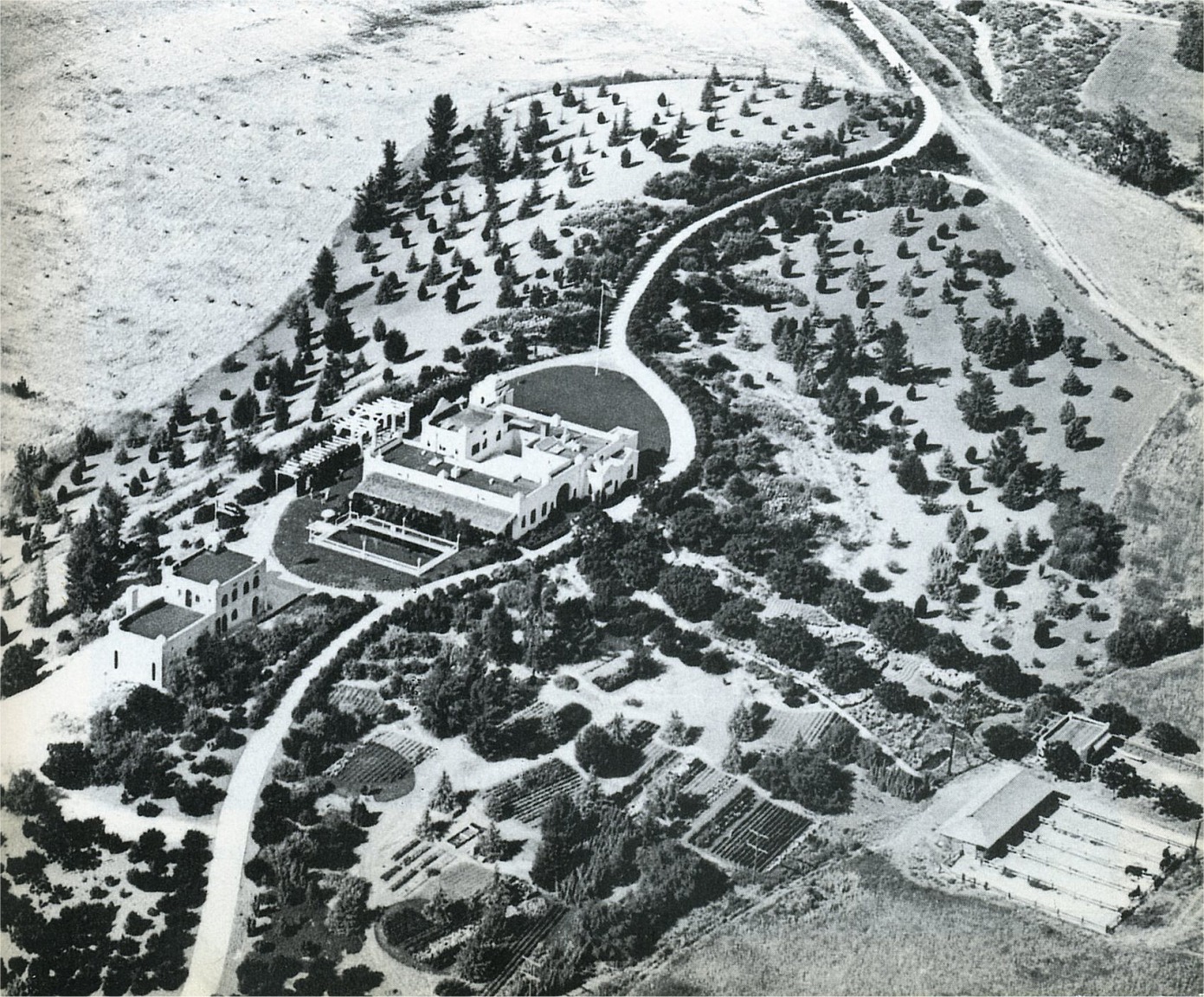
By 1923, the city of Los Angeles had completely surrounded Tarzana Ranch, and Burroughs sold a portion of it for homesites. In 1930, a post office was established in the community, and the three hundred residents held a contest to find a name for the new community. The winning entry was “Tarzana.” Today, Tarzana has its own park, library, freeway, banking facilities, medical buildings, country clubs, and a bright future.
In 1923, Edgar Rice Burroughs became the first author to incorporate himself. By the mid-1930s, he was “big business.” Daily and Sunday comic strips appeared in over 250 newspapers all over the world; a Tarzan radio serial thrilled its listeners across the country, with Burroughs’ daughter, Joan, in the role of Jane, and her husband, James H. Pierce, as Tarzan.
Today, Tarzan television programs and films are shown on an array of different networks all over the world. A Tarzan movie plays somewhere in the world every day. With the contemporary emphasis on outer space, Burroughs’ science fiction writings are still treasured to this day.
Most importantly, he is at last receiving the critical acclaim he was denied in his lifetime. No longer is Tarzan of the Apes considered mere entertainment, and neither are Burroughs’ wild imaginings among the stars; they have become subjects for scholars and an inspiration to a new generation of writers of imaginative fiction.
He is remembered a modest man who never took himself or anything else too seriously. His friends have recalled his ready sense of humor, his great love of the outdoors, and his unbound pride in his country.
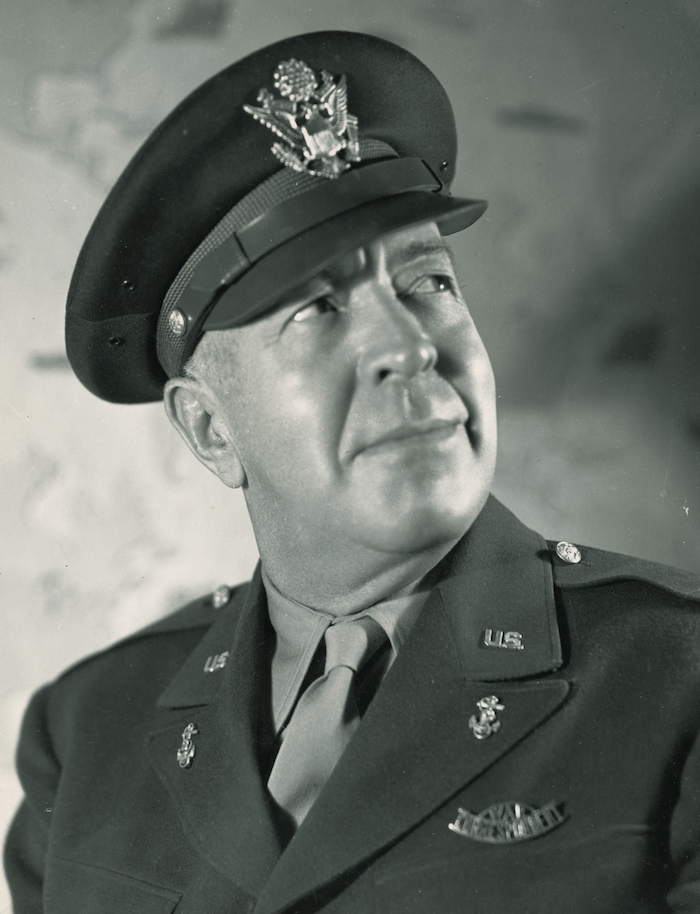 In December 7, 1941, Burroughs was a witness to the attack on Pearl Harbor, and in 1942 he became America’s oldest war correspondent, covering stories with the Pacific Fleet for United Press. He returned home from the South Pacific only after suffering a series of heart attacks. Ironically, he was unable to find a suitable home in Tarzana, and he spent his remaining years in a modest house in nearby Encino.
In December 7, 1941, Burroughs was a witness to the attack on Pearl Harbor, and in 1942 he became America’s oldest war correspondent, covering stories with the Pacific Fleet for United Press. He returned home from the South Pacific only after suffering a series of heart attacks. Ironically, he was unable to find a suitable home in Tarzana, and he spent his remaining years in a modest house in nearby Encino.
It was there, on March 19, 1950, that Edgar Rice Burroughs set down his pen for the last time.
On this momentous occasion of the corporation’s centennial, which is a testament to the lasting vision and enduring legacy of the Master of Adventure, we honor and salute Edgar Rice Burroughs, our company’s founder. We humbly follow in the footsteps of this literary giant, who has laid down the foundation of our path through his entrepreneurial spirit and steadfast determination. We continue be inspired by Mr. Burroughs as we chart the course of the corporation into the future, ever striving to maintain the high quality of entertainment for which he will be remembered for as long as there are people to read his wondrous stories.
© Edgar Rice Burroughs, Inc. All Rights Reserved. Trademarks Tarzan®, Tarzan of the Apes™, A Princess of Mars®, and Edgar Rice Burroughs® Owned by Edgar Rice Burroughs, Inc. Associated logos, characters, names, and the distinctive likenesses thereof are trademarks or registered trademarks of Edgar Rice Burroughs, Inc.







